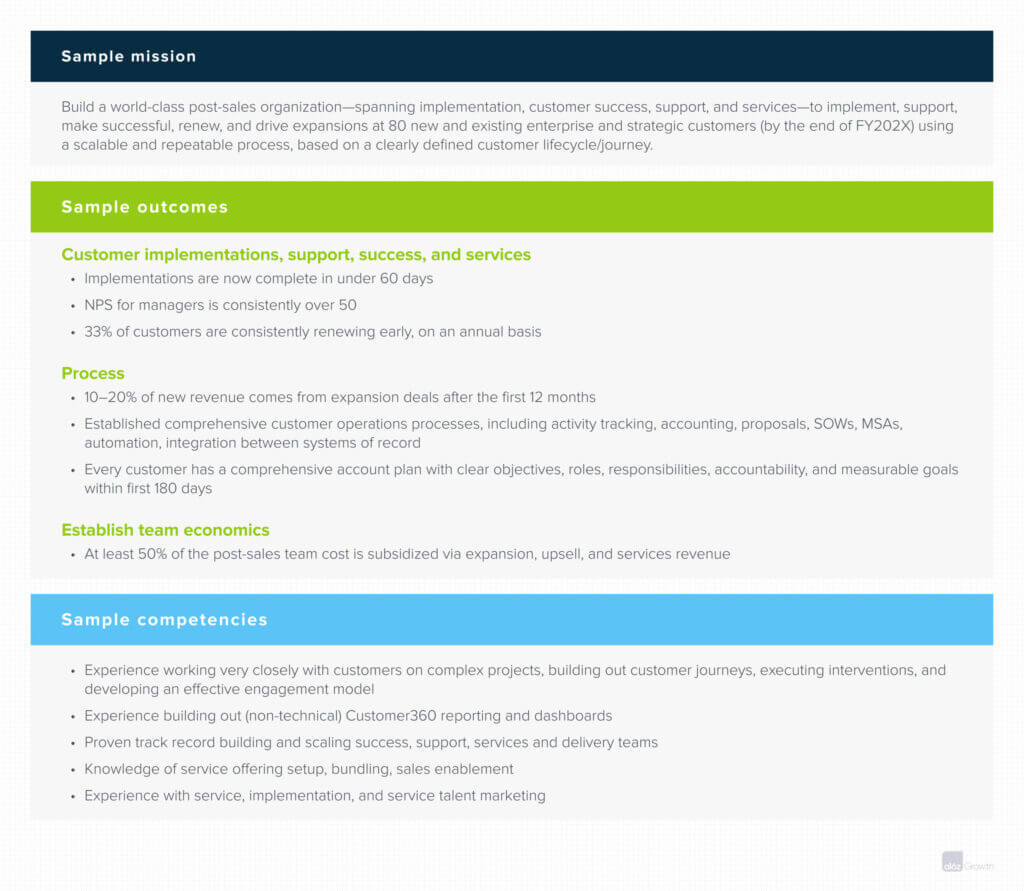As a company grows its headcount, leadership can spend their time building out internal systems to scale the internal organization at the expense of focusing on the customer—and it’s the CEO’s job to relentlessly push the company’s focus back onto that customer. Your chief customer officer (CCO) ensures that the entire company anticipates and solves customer problems and helps customers realize the value of your products.
The rise of the CCO directly reflects changing customer expectations and the increased use of subscription- and consumption-based pricing models. With the rise of bottom-up adoption and SaaS over the past 10 years, customer success has evolved from taking customer support tickets to a strategic organization focused more holistically on customer health, retention, and growth—often with success measured in terms of customer retention, account expansion, and net revenue retention (NRR). When software was sold as an annual contract with money paid up front, you could leave it to the customer to figure out how to implement your product and get value out of it. Now, the responsibility is back on you to make sure customers realize the value of your product. Especially for enterprise SaaS companies, these new pricing models mean more revenue comes from growing an account post-sales than from the initial sale, so it’s important to both generate expansion leads from within your existing customers and refine the motion for account expansion.
The way you fuel your growth is through your current customers. Take any good growing company growing at 50 or 60%, and half their revenue or more is coming from their current customers. Renewals aren’t just part of the game—it is the game to figure out: how do I grow this account? That’s the value of post-sales. It drives topline revenue.
—Hatim Shafique, COO, former CCO, Databricks on a16z Podcast: The Rise of the CCO
Your CCO makes sure the voice of the customer is represented across every function in your org. They help your product team prioritize features based on customer needs, work with sales and marketing to identify leads and expansion targets within your current customer base, turn existing customers into product evangelists, and quickly identify and close gaps between the customers’ expectations and experience. And they do all of this with an eye toward efficiency, often segmenting customers to run different service and support models for different types of accounts. This way, customer success becomes a revenue driver rather than a cost center.
All day, every day, I just think about: how do we expand value? How do we enhance experience? A large part of my role is being a mirror to the organization of what we’re doing well and where we need to improve or close gaps in the customer experience.
—Robert Stobaugh, CCO, Samsara
TABLE OF CONTENTS
When to hire
TABLE OF CONTENTS
The CCO role is especially popular in enterprise companies, and this guide focuses chiefly on the problems these companies face. You’ll typically hire a CCO because:
- Your org becomes too complex for your existing leader—likely a VP of customer success or something similar—to navigate. The CCO is a fundamentally cross-functional role and the bigger your company, the more likely you need a C-level executive to ensure that the voice of the customer is consistent across the entire organization.
- You’re seeing the same customer issues arise. A very common sign that your customer success organization is broken is a gap between pre- and post-sales, perhaps in the handoff from sales to customer success. You might need a CCO to come in, break the logjam, and help the organization make decisions it otherwise wouldn’t make cross-functionally.
- Your current leader is unable to hire enough customer support managers to support the current sales forecast. It’s risky to hire based on your sales forecast, but if your sales team is forecasting significant growth, you might need to bring on a customer success leader who can rapidly scale the customer success function to support that goal. In these instances, it’s critical to have confidence in your sales leader’s forecasts.
- Your enterprise reps need to be more focused on selling, so you need to build out a dedicated function for training and onboarding customers. This is especially important if you serve multiple customer segments with different models of post-sales management.
- For instance, you might need a dedicated function to build out high-touch relationships with customers that have higher annual contract values (ACVs), high potentials for expansion, or more complex use and install cases.
- If you run an open source company, you might need a dedicated motion to ensure that your enterprise customers get value out of your paid offering and don’t churn in favor of your free open source offering.
Writing the MOC
We discuss writing a mission–outcomes–competencies (MOC) document in greater detail in The Hiring Process.
What core competencies should you look for in your CCO?
On balance, candidates’ fundamental capabilities are more relevant than specific functional backgrounds when hiring for this role. Because customer success is a relatively new function, there aren’t too many experienced CCOs in the talent pool. Unless you’re a preeminent growth company and willing to pay a lot for an established CCO, chances are you’ll bring on an executive who has led support, services, sales, or business development, then assess if they have the skills to make the leap to CCO.
These skills typically include:
- Setting up teams and processes for listening to customers, spotting patterns in their feedback, and synthesizing those patterns into priorities.
- This is particularly important for consumer companies. In these cases, the CCO doesn’t interface directly with customers and instead needs to set up systems to listen to and aggregate themes for their feedback. A growth marketing background can be very helpful in this instance.
- Quantifying how the customer service org drives topline revenue, particularly in terms of net revenue retention.
- Value engineering. A CCO who has experience coming in near the end of a sales process to articulate how a particular customer might realize the product’s value can turn customers into advocates and references for your product.
- Effectively segmenting customers to provide the right level of service, which maintains the customer success org’s efficiency.
- Making data-driven decisions based on product telemetry, customer feedback, net promoter scores (NPS), and other data sources.
- Facilitating high-touch customer service. If you run an enterprise company, your CCO should have extensive experience building relationships with your specific customer base and being accountable to the promises they make to customers.
- Working cross-functionally to create scalable processes and customer solutions. For instance, they might need to partner with finance, sales, and product to negotiate a settlement with an entire customer cohort.
- Recruiting, hiring, and retaining top customer success talent, and implementing ratio-based systems around hiring and scaling.
What functions should your CCO own?
Every company defines the CCO differently, but CCOs generally manage some of the following functions:
- Services
- Support
- Partnerships
- Value engineering
- Community marketing, including developer relations
What does success look like for your customer service org and for your CCO?
Because the CCO is such an amorphous role, it’s critical to know what results you want from your customer success function. Do you want to increase renewals? Speed up onboarding and time-to-value? Improve frontline support so you can filter better customer feedback into your roadmap? Your answers to these questions will help a great CCO partner with your finance leader to develop the right models for long-term gains and track the right metrics to hold the customer success org accountable to your particular goals.
Developing the right models for long-term gains
It’s especially important for growth-stage companies to develop a model or formula for segmenting and investing in customers that can scale and demonstrate long-term profitability and efficiency. Particularly if you budget customer success under COGS, your CCO needs to be able to demonstrate how your customer success function improves your gross margins.
We built a customer maturity model that can calculate the stickiness of an account. It’s a combination of a lot of things, from how much money have they spent, to what products are they building and do those products drive revenue? Are we part of the revenue line for that customer? I always try to answer the question: if there’s a budget cut, will we get cut or will some other tool get cut?
—Hatim Shafique, COO, former CCO, Databricks on a16z Podcast: The Rise of the CCO
Tracking the right metrics
Though most companies measure CCOs by NRR, it can take up to a year to measure and is a lagging indicator of success. So what are the leading indicators your CCO is measuring to make sure that the customer success org is creating value for the customer? Great CCOs will identify leading indicators for each part of the customer success org and train their teams to move those metrics as efficiently as possible. If the customer success org successfully moves those numbers, the lagging indicators will very likely improve.
These leading indicators will change from company to company, but some CCOs drive growth by defining leading indicators for the different types of revenue their companies bring in. For instance, some CCOs define metrics that predict renewals (customer health score), upsells (customer success–qualified leads), and new business (customer success–qualified advocacy)—then bonus their CSMs based on hitting those metrics.
One of the most challenging parts of the CCO job is that you can have a scoreboard with 15 metrics on it, and all of them are important for keeping the symphony going. For us we’re focused on ultimately driving outcomes that drive revenue growth, so the three metrics we measure our CSMs are the three metrics—aside from gross renewal rate—I care the most about for our organization.
—Allison Pickens of Gainsight on a16z Podcast: The Rise of the CCO
Archetypes and backgrounds
To help you think through the experience you need your CCO to have, below we outline 2 different types of CCOs we’ve seen in the market and the problems they tend to address. These archetypes are helpful ways to pattern-match your needs with a candidate’s skill set. They’re not hard-and-fast rules, and you are unlikely to find a candidate with just one of these backgrounds.
The B2B CCO
Enterprise customer success requires significantly more interactions than any other market. The B2B CCO creates a high-touch, consultative experience that begins during the sales process and spans through implementation and support. They’ll often need to map different support and service motions onto different types of customers and onto customers with different ACVs.
Generally, these CCOs own services, success, renewals, and sales support. They typically measure their success through sales-related metrics, like compressing sales cycles, increasing sales productivity, and growing faster in existing accounts.
The community CCO
A company with a core community—such as a robust open source project or collaboration software—will often want a leader who has extensive experience managing communities. A strategic community CCO builds strong user networks and communities and creates a continuous feedback loop between your company and your customers to inform product decisions. Great community CCOs can also turn your best community members into product evangelists who help drive sales as well as extend the value of the product with new templates, use cases, and documentation.
These CCOs typically own the community function, along with support, services, and partnerships, and they generally measure their success through product-related metrics like shortening time-to-value or time-to-market, higher NPS scores, or shipping key community-requested features.
Sample MOC
Setting up your CCO for success
We cover best practices in The Hiring Process, but we’ve included some recommendations below for what different members of your executive team may want to focus on when interviewing customer success leaders.
Are you creating a customer-centric culture in your org?
Creating a customer-first culture—which means that all functions will have customer-first goals in their own OKRs and roadmaps—is key to setting up your CCO for success, and it has to come from the top. Establishing this culture sets the CCO up as a “pull” rather than a “push” role: the CCO won’t push an agenda onto other teams; instead other leaders will come to the CCO to make sure they’re serving the customer.
We have an expectation that every VP and up meets with at least 5–10 large customers per year. They get out there in person, sit down, and spend 4 hours talking to the customer and absorbing everything they have to say. This helps these executives quickly solve the things that matter most to our customers, and it just makes it so much easier to get stuff done when other executives see the customer needs directly.
—Robert Stobaugh, CCO of Samsara
Can your candidate create the right formulas and metrics to track?
Being customer-obsessed doesn’t work at scale unless your CCO, CFO, and CEO have agreed-upon ways to invest in and measure customer success. Without these formulas, many companies either under- or overinvest in the function. In interviews and working sessions, you may find it especially worthwhile to test your candidate’s ability to generate processes and formulas that create clarity around your business objectives and drive results.
Can your candidate shorten the customer feedback loop for your product team?
With the rise of bottom-up adoption and SaaS, products themselves—as opposed to sales—have become a key revenue driver for most companies. But to continue to provide customers value and earn that revenue, the product team needs access to clear and continuous customer feedback. Great CCOs provide value by tightening the feedback loop between customers and your company. If your candidate can’t point to examples showing they’ve established clear listening and communication mechanisms with customers and communities, that’s a red flag.
Where does sales end and customer success begin in your org?
Particularly in enterprise companies, sales and customer success need to work in lockstep while having clearly defined swim lanes, so it’s especially important to define how customer success interacts with customers and decide how to incentivize expansion. We almost always see account managers or sales teams own expansion, so the goal with customer success is to figure out how to partner with the sales team to make sure your customers are realizing value. Some companies also create customer success–qualified leads (CSQLs) that track sales opportunities back to customer success but compensate sales on closing those deals.
What is [customer success’s] role? What are they doing with customers? Are they reporting day-to-day on how the customers are adopting the product? Are they actually going to own the transaction and walk the halls and build the relationship and take everyone out for dinner and formulate a deal around that? Having 2 people doing the same job never works out, and it’s the tendency of the sales rep to protect the account and say, ‘don’t communicate anything to this customer without talking to me,’ especially as you get closer to the renewal of the transaction. They’re trying to control every aspect of the account. Having 2 or 3 chefs in the kitchen doesn’t work out.—Hatim Shafique, COO, former CCO, Databricks on a16z Podcast: The Rise of the CCO
Test your candidate’s tolerance for ambiguity: flip the interview
Opening interviews by asking what questions the candidate has tests their ability to handle ambiguity and thinking on their feet. Can they drive the conversation? This mirrors what they’ll need to do in high-stakes customer conversations.
Thanks to Cat Arndt, Abbas Haider Ali, Amanda Kleha, and Robert Stobaugh for contributing their hard-earned wisdom to this piece.
Further reading
We’ve drawn insights from some of our previously published content and other sources, listed below. In some instances, we’ve repurposed the most compelling or useful advice from a16z posts directly into this guide.
Rising and Falling: Like a Phoenix, Kleiner Perkins’s Grit podcast with Ozge Ozcan, Instabase CCO (former MongoDB)
Ozcan shares her triumphs, hurdles, and learnings from running a customer success team at Instabase. From hiring 60 people in just 1 year to developing metrics to spotting and fixing a broken process, Ozcan weaves together her personal and professional experiences to show how she built successful customer-centric teams.
The Rise of the CCO, a16z Podcast with Krista Anderson-Copperman, Allison Pickens, Hatim Shafique, and Matt Levy
What’s the difference between a CCO and a VP of customer success? This podcast brings together a team of experts to dissect this newer role on the executive bench, including the CCO’s career path and strategic value.
Twitter thread, Martin Casado on the decline of presales and its effect on go-to-market tooling
The shift to product-led growth, or bottom-up sales, puts greater emphasis on the post-sale customer journey. Post-sales staffing and customer success are more important than ever, creating opportunities for companies to rethink people and systems to generate greater value from existing customers.
The Strategies Behind Figma’s $10 Billion Valuation, Kleiner Perkins’s Grit podcast with Amanda Kleha, Figma CCO
Kleha knows a thing or 2 about turning the voice of the customer into value. Here, she discusses her experiences at Zendesk and Figma with different sales motions, interviewing strategies, and how to stay customer focused when making decisions.
-

Andrea Simon is a partner on the Talent Network team, focused on executive talent.
-

Brian Curran is a partner on the Talent Network team, focused on executive talent.
- Follow
-

David Belden is a partner on the Talent Network team, focused on executive talent.
-

Stephanie Doppelt is a partner on the Talent Network team, focused on executive talent.


